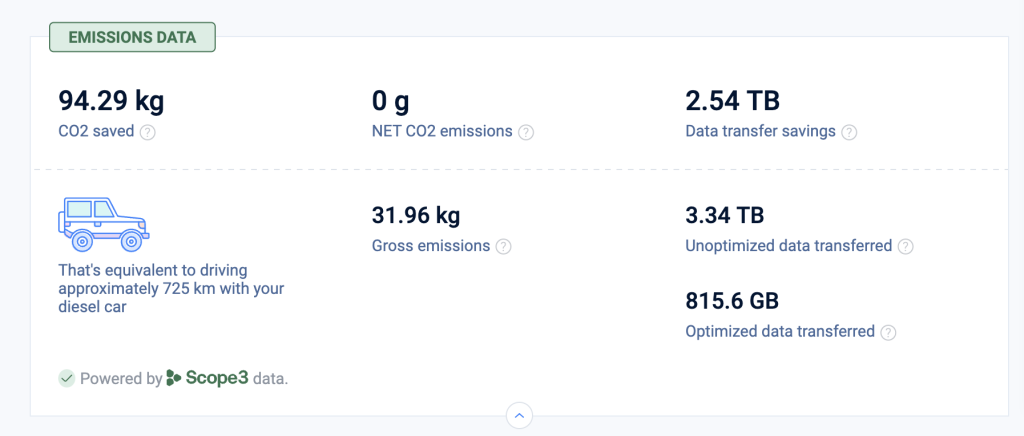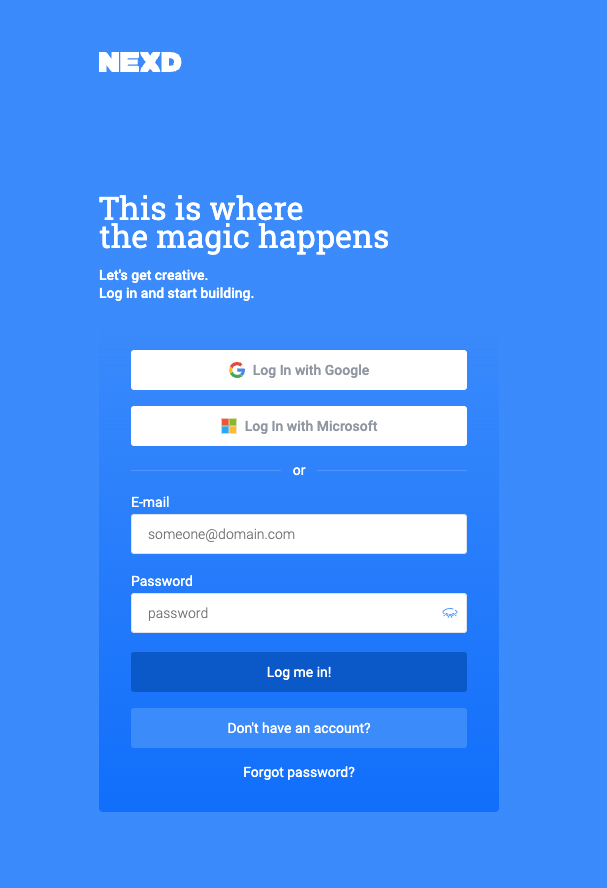How Nexd ensures sustainable advertising?
Updated in January 2025.
Sustainability in programmatic advertising has been gaining momentum for quite some time, with legislation being put in place and enforced in Europe and in Australia and New Zealand. Nexd has its own role to play to help advertisers make their digital advertising greener.
In this article, we describe how we calculate the CO₂ savings shown in our Campaign Manager analytics.
Below, you will find answers on all things Nexd sustainability.

What sustainable ad-serving KPIs do we track?
To ensure our green ad serving status, we compare the amount of CO₂ that advertisers save with us versus if they would have used generic HTML5s. Additionally, we track our Scope 2 and Scope 3 emissions and as well as set targets to improve the emissions from those to improve their emissions.
- We reduced 1750 tonnes of CO₂ in 2022. We were looking to reduce 2500 tonnes in 2023, the actual saving ended up being 3277 tons.
- Our current CO₂ emissions from Scope 2 and 3 are 1.84 tonnes per year per team member. We aim for 1-1.1 tonnes per team member to be sustainable; ideally, this number should not exceed 1 tonne per person. This will be achieved by switching to a greener office electricity provider, increasing recycling mediums, and opting for more vegetarian office meals.
What’s the effect of our processes on CO₂ emissions?
As there are several elements that contribute to the lower emissions from Nexd ads, we will break them down in detail:
Creatives – Our average interactive creative size reduction is 83.24% for video creatives and 41.36% for image creatives compared to the traditional HTML5. Plus, with our ads using GPU and not CPU for processing, the ads load faster, and that’s an energy-saving feature as well, next to the size reduction. GPU uses 30% fewer resources to show rich media creatives than HTML5 or 2D Canvas (or CPU).
Development – We use Amazon Web Services (AWS), we use data centres in two regions GovCloud (US-West) and Europe (Ireland), out of which the USA data centre regions are powered 100% on renewable energy and for Europe and APAC region data centres is matched by renewable energy sources.
Ad-serving – Our ad-serving side ad server is supported by Cloudflare; we saved 22 tonnes of carbon in 2021 by using their services. Cloudflare, as a company, is also looking to offset all its historical emissions by 2025. Additionally, they are working on extending the lifecycle of their hardware and implementing sustainable options for their offices. Thanks to our infrastructure partner, our data centres are in close proximity to the end user. Cloudflare emissions inventory report for 2022 is available here: Cloudflare Impact Report.
What are our internal benchmarks?
Much of our CO₂ savings come from our AI algorithm, which automatically optimizes the creative size without compromising quality (development process above), and our processing source, which aids in faster loading of the creatives. Additionally, we have set a size limit for the creatives produced using our platform. Ideally, creatives made on Nexd do not exceed these limits.
Interactive creative sizes need to stay under a certain size.
- Less than 200kb for image ads*
- Less than 650kb for video ads*
*This depends on assets chosen by the clients; for more complex creatives, the size limit can be higher.
In our 200m2 office, we keep the monthly electricity usage below 500kWh. Due to the lack of benchmarking data on the electricity use of offices in Estonia, we reference the 4000kWh average monthly use of UK offices of the same size instead.
We do not use any single use cups or plates in the office and always recycle any plastic or glass bottles, we ensure that none gets thrown into landfills. We are continuously looking to increase our office recycling efforts and will share our updates as we progress in this field.
We have limited business travel and do not have more than eight business flights per team per year (combined amount for all team members).
The world around us is changing at an incredible pace, and we must adjust. When we talk about the Earth we live on, its climate and the effect of climate change, companies must make changes and improvements. However, when everyone is racing to label themselves as green companies, something will have to give. It might be that some will do it just for the sake of doing it, others have no idea what they are doing, and some are just trying to drown their audience in complicated jargon.
As we claim to be a sustainable ad server and creative management platform, we felt the need to explain our claims and back them up with research and proof. We have implemented a CO₂ calculation feature in our platform, which helps you realise the savings you get using NEXD’s creative and ad-serving tools. Continue reading to understand how it works.

In order to make it easier to find the information needed, this article is broken down into parts:
- How do we calculate CO₂ emitted by advertising campaigns?
- How does the weight of creatives influence the energy required by ad servers?
- How are the CO₂ savings in the Campaign Manager calculated?
- How are Nexd creative solutions and ad-serving better for the environment?
- How do data centres contribute to advertising emissions footprint?
- Did you know you can also use Nexd as an ad-serving tool?
How do we calculate CO₂ emitted by advertising campaigns?
The primary polluting source in displaying digital ads are servers that handle requests and send the visuals to the viewer (however, as we use servers running on renewable energy . Nexd’s services calculate the ad weight and multiply it by how many times we have had to serve the ad files. Based on the research by the International Energy Agency (IEA) and other agencies shown in the studies, we have calculated that, on average, 1 GB of network transfers requires 0.06 kWh of energy. That’s the equivalent of burning a 50W light bulb for 12 hours.
To calculate the energy requirements for each ad, we consider the energy usage in each market where the impressions will be shown. Based on that, we will calculate how much CO₂ energy production creates in each country.
For example, a video ad campaign serving 100 million impressions in the United Kingdom will generate around 4 tons of CO₂ using standard ad-serving solutions.
How does the weight of creatives influence the energy needed by ad servers?
We know that data servers can be quite polluting as they handle and serve A LOT of data worldwide. Most of the time, the data bandwidth marks how much energy the data servers use – gigabytes (GB) served equals the energy used. We found that the most accepted number was 0.06 kWh per GB delivered. Therefore, every ad should be as lightweight as possible and make as few requests as possible so that the server side doesn’t have to initiate new deliveries too often. Although 0.06kWh is quite a small number if we look at it as one ad, every ad request is the full ad downloaded repeatedly. So a 1MB advertisement served 100 million times is 100,000 GB bandwidth.
An ad campaign with a video of 100 million impressions running in the United Kingdom using Nexd ad-serving solutions will generate around 1.5 tons of CO₂.
Nexd shows in all of its analytics reports (available for full analytics access users) the CO₂ emissions saved using Nexd ad serving. Nexd sustainable ad server runs on 100% renewable energy. In cooperation with our infrastructure partner on markets where renewable energy is not well attainable, we invest in carbon offsets or removals on markets.
How are the CO₂ savings in the Campaign Manager calculated?

Our creative emissions savings calculations now powered by Scope3 data, the industry leader in ad supply chain emissions measurement, helping us offer transparency and accuracy in reducing the carbon footprint of digital ads.
Our calculations are based on a formula provided by Scope 3 (their methodology).
How the Standard Industry Formula Works
- Based on Industry Standards:
- The savings formula is based with Scope3’s methodology, which evaluates emissions across the ad supply chain, ensuring credible and comparable results.
- Emission Sources Covered:
- The formula quantifies emissions savings from:
- Creative Distribution: Reduced data transfer due to Nexd’s optimized lightweight ad designs.
- Ad Selection and Delivery: Fewer supply chain emissions by minimizing redundant paths.
- It includes emissions from consumer devices, maintaining consistency with Scope3’s set industry-standard.
- The formula quantifies emissions savings from:
- Key Metric: gCO₂PM (grams of CO₂ per 1,000 impressions):
- Nexd’s formula calculates the reduction in emissions using this standardized metric, showing clear, measurable improvements in your campaigns.
- Validated Comparisons:
- Using Scope3’s methodology, Nexd compares the emissions of traditional ad creatives to our lightweight formats, ensuring that the reduction is verifiable and impactful.
How are Nexd creative solutions and ad-serving better for the environment?
The technical difference between Nexd’s solutions and HTML5 comes from our processing source. Nexd’s creative solutions use WebGL technology, which uses GPU for processing instead of CPU. CPU stands for Central Processing Unit, and everything that happens on a website uses that as a resource. Nexd solutions use GPU, which means Graphics Processing Unit, which helps show our ads without having to fight for other resources. This also reduces our ad load time. Additionally, this helps us to have a smooth user experience on all publisher sites, as the impact of performance is minimal.
Nexd’s ad serving has been certified by Green Web Foundation to run fully on renewable energy. Our serving side ad server is Cloudflare. Cloudflare’s market-based Scope 2 emissions are zero for 2020 as a result of the company’s renewable energy purchases. Cloudflare purchased renewable energy attribute certificates (I-RECs, RECs, REGO, and others) through its partner 3Degrees, equivalent to Cloudflare’s global facilities and network energy usage. All purchases were consistent with RE100 technical criteria. The ad server info can be found here.
How do data centres contribute to advertising emissions footprint?
Most of us don’t actively think about what it takes to make “the internet happen”; however, there are physical places with hundreds of data centres where data is stored, which deliver our emails and stream our films. The truth is that all these activities require a lot of energy and emit CO₂. As described by Yale Environment 360, “the processors in the biggest data centres hum with as much energy as can be delivered by a large power station, 1,000 megawatts or more. And it can retake as much energy to keep the servers and surrounding buildings from overheating.” Today there are efforts to make data centres greener and push them to use more renewable energy.
Did you know you can also use Nexd as an ad-serving tool?
As Nexd is also a sustainable ad server, you don’t have to build your ads with us; you can benefit from our tool still. Uploading and exporting creatives through our Campaign Manager helps to optimise the creative size thanks to our WebGL technology, and the emission savings will also apply to your external creatives.

Get Started
Sign up to Nexd Campaign Manager for a free 14-day trial and start creating environment-friendly and highly engaging programmatic creatives!
